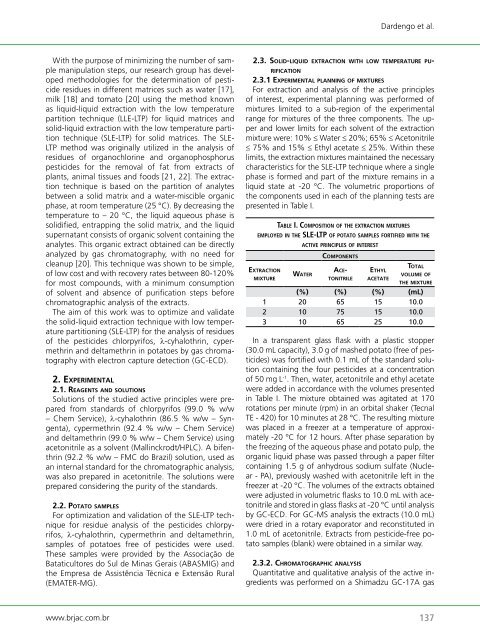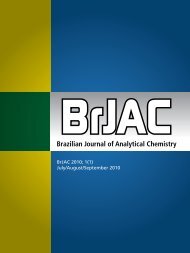Brazilian Journal of Analytical Chemistry - BRJAC - Brazilian Journal ...
Brazilian Journal of Analytical Chemistry - BRJAC - Brazilian Journal ...
Brazilian Journal of Analytical Chemistry - BRJAC - Brazilian Journal ...
You also want an ePaper? Increase the reach of your titles
YUMPU automatically turns print PDFs into web optimized ePapers that Google loves.
With the purpose <strong>of</strong> minimizing the number <strong>of</strong> sample<br />
manipulation steps, our research group has developed<br />
methodologies for the determination <strong>of</strong> pesticide<br />
residues in different matrices such as water [17],<br />
milk [18] and tomato [20] using the method known<br />
as liquid-liquid extraction with the low temperature<br />
partition technique (LLE-LTP) for liquid matrices and<br />
solid-liquid extraction with the low temperature partition<br />
technique (SLE-LTP) for solid matrices. The SLE-<br />
LTP method was originally utilized in the analysis <strong>of</strong><br />
residues <strong>of</strong> organochlorine and organophosphorus<br />
pesticides for the removal <strong>of</strong> fat from extracts <strong>of</strong><br />
plants, animal tissues and foods [21, 22]. The extraction<br />
technique is based on the partition <strong>of</strong> analytes<br />
between a solid matrix and a water-miscible organic<br />
phase, at room temperature (25 °C). By decreasing the<br />
temperature to – 20 °C, the liquid aqueous phase is<br />
solidified, entrapping the solid matrix, and the liquid<br />
supernatant consists <strong>of</strong> organic solvent containing the<br />
analytes. This organic extract obtained can be directly<br />
analyzed by gas chromatography, with no need for<br />
cleanup [20]. This technique was shown to be simple,<br />
<strong>of</strong> low cost and with recovery rates between 80-120%<br />
for most compounds, with a minimum consumption<br />
<strong>of</strong> solvent and absence <strong>of</strong> purification steps before<br />
chromatographic analysis <strong>of</strong> the extracts.<br />
The aim <strong>of</strong> this work was to optimize and validate<br />
the solid-liquid extraction technique with low temperature<br />
partitioning (SLE-LTP) for the analysis <strong>of</strong> residues<br />
<strong>of</strong> the pesticides chlorpyrifos, λ-cyhalothrin, cypermethrin<br />
and deltamethrin in potatoes by gas chromatography<br />
with electron capture detection (GC-ECD).<br />
2. experImental<br />
2.1. re a g e n t s a n d s o l u t Io n s<br />
Solutions <strong>of</strong> the studied active principles were prepared<br />
from standards <strong>of</strong> chlorpyrifos (99.0 % w/w<br />
– Chem Service), λ-cyhalothrin (86.5 % w/w – Syngenta),<br />
cypermethrin (92.4 % w/w – Chem Service)<br />
and deltamethrin (99.0 % w/w – Chem Service) using<br />
acetonitrile as a solvent (Mallinckrodt/HPLC). A bifenthrin<br />
(92.2 % w/w – FMC do Brazil) solution, used as<br />
an internal standard for the chromatographic analysis,<br />
was also prepared in acetonitrile. The solutions were<br />
prepared considering the purity <strong>of</strong> the standards.<br />
2.2. potato samples<br />
For optimization and validation <strong>of</strong> the SLE-LTP technique<br />
for residue analysis <strong>of</strong> the pesticides chlorpyrifos,<br />
λ-cyhalothrin, cypermethrin and deltamethrin,<br />
samples <strong>of</strong> potatoes free <strong>of</strong> pesticides were used.<br />
These samples were provided by the Associação de<br />
Bataticultores do Sul de Minas Gerais (ABASMIG) and<br />
the Empresa de Assistência Técnica e Extensão Rural<br />
(EMATER-MG).<br />
www.brjac.com.br<br />
2.3. so l Id-lIquId extractIon w It h l o w temperature pu-<br />
rIfIcatIon<br />
2.3.1 experImental p l a n n In g o f mIxtures<br />
For extraction and analysis <strong>of</strong> the active principles<br />
<strong>of</strong> interest, experimental planning was performed <strong>of</strong><br />
mixtures limited to a sub-region <strong>of</strong> the experimental<br />
range for mixtures <strong>of</strong> the three components. The upper<br />
and lower limits for each solvent <strong>of</strong> the extraction<br />
mixture were: 10% ≤ Water ≤ 20%; 65% ≤ Acetonitrile<br />
≤ 75% and 15% ≤ Ethyl acetate ≤ 25%. Within these<br />
limits, the extraction mixtures maintained the necessary<br />
characteristics for the SLE-LTP technique where a single<br />
phase is formed and part <strong>of</strong> the mixture remains in a<br />
liquid state at -20 °C. The volumetric proportions <strong>of</strong><br />
the components used in each <strong>of</strong> the planning tests are<br />
presented in Table I.<br />
taBlE i. Co m P o s i t i o n o f thE ExtraCtion m i x t u rE s<br />
EmPloyEd in thE slE-ltP o f Potato samPlEs fortifiEd w i t h thE<br />
aCtivE PrinCiPlEs o f intErEst<br />
components<br />
Dardengo et al.<br />
ex t r a c t I o n<br />
m Ix t u r e<br />
water<br />
ac etonItrIle<br />
et h y l<br />
acetate<br />
to t a l<br />
v o l u m e o f<br />
t h e m Ix t u r e<br />
(%) (%) (%) (mL)<br />
1 20 65 15 10.0<br />
2 10 75 15 10.0<br />
3 10 65 25 10.0<br />
In a transparent glass flask with a plastic stopper<br />
(30.0 mL capacity), 3.0 g <strong>of</strong> mashed potato (free <strong>of</strong> pesticides)<br />
was fortified with 0.1 mL <strong>of</strong> the standard solution<br />
containing the four pesticides at a concentration<br />
<strong>of</strong> 50 mg L -1 . Then, water, acetonitrile and ethyl acetate<br />
were added in accordance with the volumes presented<br />
in Table I. The mixture obtained was agitated at 170<br />
rotations per minute (rpm) in an orbital shaker (Tecnal<br />
TE - 420) for 10 minutes at 28 °C. The resulting mixture<br />
was placed in a freezer at a temperature <strong>of</strong> approximately<br />
-20 °C for 12 hours. After phase separation by<br />
the freezing <strong>of</strong> the aqueous phase and potato pulp, the<br />
organic liquid phase was passed through a paper filter<br />
containing 1.5 g <strong>of</strong> anhydrous sodium sulfate (Nuclear<br />
- PA), previously washed with acetonitrile left in the<br />
freezer at -20 °C. The volumes <strong>of</strong> the extracts obtained<br />
were adjusted in volumetric flasks to 10.0 mL with acetonitrile<br />
and stored in glass flasks at -20 °C until analysis<br />
by GC-ECD. For GC-MS analysis the extracts (10.0 mL)<br />
were dried in a rotary evaporator and reconstituted in<br />
1.0 mL <strong>of</strong> acetonitrile. Extracts from pesticide-free potato<br />
samples (blank) were obtained in a similar way.<br />
2.3.2. ch r o m a t o g r a p h Ic a n a l y s Is<br />
Quantitative and qualitative analysis <strong>of</strong> the active ingredients<br />
was performed on a Shimadzu GC-17A gas<br />
137



